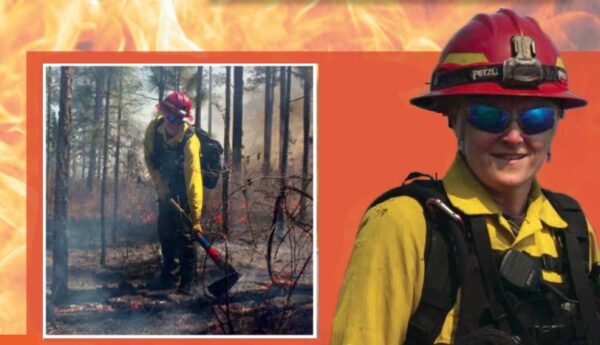Wildfires are dangerous to nature, right? Every year, the news is filled with reports about raging wildfires damaging forests and forcing people to evacuate. More than 8,000 wildfires tore through California last year, burning more land than the entire state of Delaware. Fortunately, fire safety officers are on the job, working hard to protect nature from wildfires. You’d think that their ideal number of wildfires per year would be zero, right? Wrong.
Meet wildlife biologist and fire safety officer Shan Cammack, who fights fire with fire. That means that she actually knows how to set– and control– fires to restore wildlife and the places they need to live. It turns out that small fires actually prevent bigger fires from doing major damage. Anna Yellin Shulimson from MUSE Magazine sat down to talk to Cammack about her exciting job.
Q. What is a prescribed burn?
A. Prescribed burning is a safe way to apply a natural process (fire), ensure ecosystem health, and reduce the risk of wildfire. A prescribed burn is carried out by trained crews when the weather and fire fuel conditions are in “prescription.”
Q. How do you know what to burn?
A. We monitor things like temperature, relative humidity, and winds. Before we burn, we must follow what’s written in our burn plan. The plan is essential. It’s a written document that describes the site, our ecological objectives, key weather parameters, safety concerns, and the personnel and equipment we will need.
Q. How do prescribed burns help?
A. Fires were once common. Lightning strikes ignited fire, which then spread across the landscape. These regular fires burned things such as leaf litter and fallen trees and limbs, preventing these ‘fuels’ from building up in amounts that could lead to larger, hotter fires. Today, because of more people, changes in land use, and other factors, natural fires are less frequent. With prescribed burns, we try to mimic historic patterns of fire. Some of our goals include reducing fire fuels, improving the way forests look, and reducing disease and parasites (such as ticks).
A prescribed burn can kill thick shrubs, prickly briers, and other aggressive vegetation, allowing more sunlight to reach the forest floor. That gives native grasses and delicate wildflowers a better chance to live. The change helps native animals such as gopher tortoises, Bachman’s sparrows, and bobwhite quail survive and even thrive. These animals and many plants prefer woodlands that are regularly burned.
Q. How do you get ready for these burns?
A. Before we light the fire, a crew preps the burn area. This includes clearing firebreaks. These surround the area we want to burn and are designed to stop the fire from going out of bounds. We rake the firebreaks down to the dirt, remove any jackpots (large piles of fuel), and cut down nearby snags (dead trees) that might catch fire and cause a problem.
Q. What type of training is required?
A. For prescribed burns, it is important to know how to control the fire and how to put it out if you need to. Wildland firefighters take classes and must pass written and endurance tests. And each year they have to take refresher classes to stay up-to-date on the latest changes and important concepts.
Q. Do you have special equipment?
A. Yes! We wear clothes that are fire resistant. We also wear a helmet, gloves, safety glasses, and hardy boots. All of these reduce our exposure to heat. We carry radios to maintain contact with the rest of the team. We usually start the fire with a drip torch: a fuel canister with a spout designed to ignite and drop the flaming fuel where you need it.
Q. What do you use to fight fires?
A. Controlling the fire is done with hand tools, such as fire rakes. We have special wildland firetrucks, UTVs, and ATVs that carry water. But sometimes we burn in areas where you can’t use this equipment. Mop-up, which is where we put out any fire that might try to escape the burn unit, can get creative when you don’t have access to water! Sometimes all you can do is cover a burning log with dirt to smother the fire.
Q. What are some more examples of animals and plants that fire helps?
Longleaf pine historically covered much of the southeastern United States. This is a pyric community. That means the plants and animals that live in this landscape depend on fire. For a longleaf pine seet to germinate, it must meet bare mineral soil. That’s usually only made possible by fire.
One animal that lives in longleaf forests is the gopher tortoise. These reptiles eat plants and fruits found on a healthy forest floor, which means they need fires to keep that groundcover rich. Gopher tortoises also dig long tunnels in sandy soil to make their homes. The burrows protect them from fire, predators, and cold winter weather. Yet many other animal species rely on tortoise burrows for their safety and homes, as well. Examples include the eastern indigo snake, gopher frog, mice, burrowing owls, and invertebrates such as the gopher tortoise hister beetle.
You could say that all of these plants and animals require a prescription for fire!
Meet more real scientists and delve into strange but true science secrets with MUSE Magazine, the quirky yet cutting-edge STEM magazine for young people ages 9-14:.



